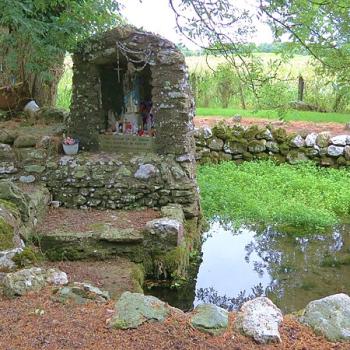Local Rituals for the Coming of Spring
Although this will be published for Imbolc/Candlemas/Purification at the end of the month, I write these words on January 6, the traditional Twelfth Day of Christmas, or, in New Orleans, the first day of Carnival. Thoughts here in this naturally pagan city turn toward all the rituals of purification for this time of year.

First, if we had a natural tree for Christmas/Yule, this week we carefully remove all the lights and decorations and tinsel from our Christmas tree, and put it on the curb for pick up. During the designated week of Epiphany, the trees are removed by the city and brought out to the marshlands for disposal. The trees sink into the wet soil, providing a handle for more earth to cling to, slowly to rebuild the devastated wetlands. It seems a proper burial for the holiday trees, a good afterlife for them, protecting all of us. (Remember: the wetlands located in South Louisiana are YOUR wetlands too, acting as a speed bump for Gulf storms and preventing the entire Mississippi Valley and Midwest from their effects.)
Many of those who reuse an artificial tree for the Yule season pack away all the red and green decorations and bring out the purple, green, and gold of Carnival/Mardi Gras. Many people here repurpose their trees and leave them up till Ash Wednesday. Or maybe till the Thursday after; it is a little difficult to get anything done in New Orleans on Ash Wednesday. (A hardcore few redecorate a third time with hearts and flowers for Valentines.)
Next, we give our houses a thorough cleaning. There are many reasons for this. Some of us have had Christmas/New Year parties; some of us have had overnight guests during the season. Some of us are anticipating the guests and parties we will have during Carnival. But some of us come from New Orleans families where the old traditions still hold, like opening all your windows and doors and sweeping out your whole house using salt, paying special attention to your doorstep.
The open widows and doors let out the “bad air” and negative energies; making sure to sweep the doorstep keeps the bad luck out and welcomes the good luck in. In a lot of cases, the folks doing this have no recollection at all of the “why” and it has become “just what we do” at this time of year. (Most of the time, they would resent it if you said it had anything to do with voodoo.) Some may call it spring cleaning, but since it’s done before spring arrives, that would be a misnomer. It’s what we do.
The parades and celebrations of Carnival will begin soon; meanwhile, we traditionalists have waited until now to enjoy our first king cake of 2016. The king cake tradition goes back to France — a brioche-type dough usually flavored with cinnamon, shaped into a ring or oval, iced in the Mardi Gras colors, with a small figure of baby Jesus baked inside. To be served first on Epiphany, the cake honors the story of the Three Magi and their visit to the Holy Family. The custom is, the person whose slice has the baby in it is declared the king or queen — and now has to buy the next king cake.

Originally served at a party or grand ball, now every office, business, church, coffee klatch, and gathering of three or more people has king cake nearly every day of the season. (A local pizza place offers one of the best; I know local AA groups that have king cake after the meeting.) Wherever you get your slice of king cake, the rule remains the same: if you get the baby, you bring the next king cake.
The original king cakes were pretty plain, and New Orleans is the grand champion city of “more is more” philosophy, thus there are now dozens of flavors of king cakes. You can have your king cake filled with cream cheese, chantilly cream, bavarian cream, chocolate (milk chocolate, German chocolate, dark chocolate and Mississippi mud), pecan praline, cherry, apple, strawberry, blueberry, lemon, peach, raspberry, and combinations of the above — I believe you get the idea. (If I’ve whetted your appetite, you can search online and find lots of local bakeries offering to ship one to you.)
By the time Imbolc arrives, our season is in full swing. This year is an early Mardi Gras (and thus an early Easter as well), so the first week of February brings the major parades. The ceremonial lighting of the flambeaux at the first night parade is a special moment for New Orleanians. The African-American carriers, in their white garb, kneel on one knee in two rows on the street at the start of the parade. (Some of the men’s families have been performing this ritual for several generations.)
Then, the fire marshal goes down the line, lighting each kerosene-fueled torch, some of them almost as old as the New Orleans celebration itself. The crowd cheers, the torch bearers stand and some begin to dance, the music strikes up, and the parade begins.
Those smoky torches are no longer needed to actually light the night parades, which are brightly lit with electric bulbs and even LCDs, but are needed to light our spirits. Even if the Carnival season brings unseasonable temperatures, we are drawn to the warmth and light of these holiday fires, just as our ancestors once were.
On the afternoon of Mardi Gras itself (don’t make the rookie mistake: Carnival is the season; Mardi Gras is the day), there’s another ritual purification. The Krewe of St. Ann, a marching group of artists and other creative types, in gorgeous handmade costumes and masks, does a stately parade through the French Quarter to Canal Street, and then back through the Quarter to the Mississippi River overlook known as the Moon Walk (after the current mayor’s father, Moon Landrieu, who instigated the transformation of the space from industrial port use to its present function as access to the river). Walking down the wooden steps to the river, the krewe and their followers pour into the river various remembrances of the past year, including the ashes of loved ones who have died. As is appropriate for such a ritual, there is both cheering and crying.
On Ash Wednesday, there will be more purification, both formal and informal. Some will go get ashes at the church service that reminds us that life is short and we all eventually return to the earth. Some will swear off all harmful or intoxicating substances (a good reminder for some of us who may need reminding that intoxication comes from substances that can be toxic). Some will fast and drink lots of water to cleanse their bodies. Some will just sleep late and take excruciatingly long showers. But it’s all purification just the same, the way we do it in the Crescent City.

















